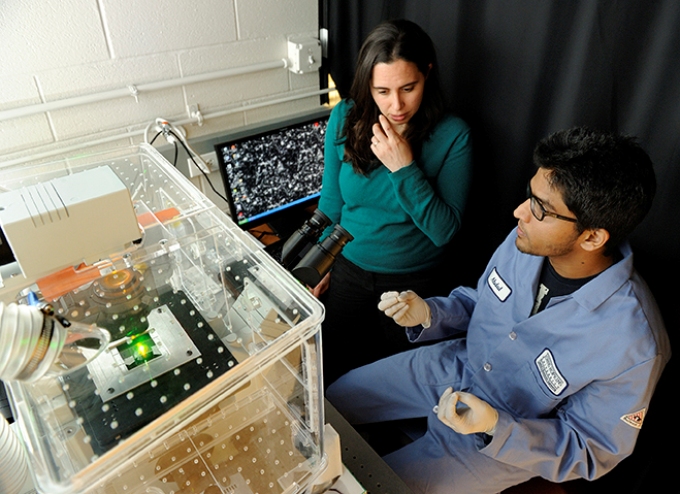Jan 6 2017
 Assistant Prof. Rebecca Schulman, left, and postdoctoral fellow Abdul Mohammed used this single-molecule fluorescence microscope to track the nanotube bridge formation process. (Photo by Will Kirk/Johns Hopkins University.)
Assistant Prof. Rebecca Schulman, left, and postdoctoral fellow Abdul Mohammed used this single-molecule fluorescence microscope to track the nanotube bridge formation process. (Photo by Will Kirk/Johns Hopkins University.)
A remarkable microscopic feat resembling a high-wire circus act was achieved by Johns Hopkins researchers when they successfully managed to coax DNA nanotubes to arrange themselves into bridge-like structures arched between two molecular landmarks on the surface of a lab dish. Examples of this unusual nanoscale feat were captured on video.
This self-assembling bridge method could probably have use in connecting electronic medical devices to living cells in the future. The findings have been reported by the team recently in the Nature Nanotechnology journal.
To explain this method, senior author Rebecca Schulman, an assistant professor of chemical and biomolecular engineering in the university’s Whiting School of Engineering, drew the analogy of a death-defying stunt shown in the movie “Man on Wire”, where Philippe Petit’s 1974 high-wire walked between the World Trade Center’s Twin Towers.
Schulman emphasized that the real-life crossing could not have been achieved without a vital piece of conventional engineering: Petit’s hidden partner used a bow and arrow to launch the wire across the gap between the towers, enabling it to be tied to each structure.
A feat like that was hard to do on a human scale. Could we ask molecules to do the same thing? Could we get molecules to build a ‘bridge’ between other molecules or landmarks on existing structures?
Rebecca Schulman, Assistant Professor, Johns Hopkins University
The research paper’s lead author, Abdul Mohammed, a postdoctoral fellow in Schulman’s lab, used another analogy to explain the molecular bridge-building feat they showed at the nanoscale level. “If this process were to happen at the human scale,” Mohammed said, “it would be like one person casting a fishing line from one side of a football field and trying to hook a person standing on the other side.”
To realize this task, the researchers looked at DNA nanotubes. These microscopic building blocks are produced by short sequences of synthetic DNA, and have become appealing materials in the up-and-coming nanotechnology construction field. The sequences are especially useful due to their ability to arrange themselves into long, tube-like structures known as DNA nanotubes.
In the Johns Hopkins research, these building blocks attached themselves to individual molecular anchor posts, signifying where the connecting bridge would start and end. The segments created two nanotube chains, with each one extending away from its anchor post. Then, similar to spaghetti in a boiling pot of water, the extending nanotube chains wriggled about, examining their surroundings in a haphazard manner. In due course, this movement enabled the ends of the two independent nanotube strands to form a contact with one another and snap together to develop a single connecting bridge span.
To understand more about the way this process occurs, the team used microscopes to see the nanotubes link to their molecular landmarks, which were labeled with various colored fluorescent dyes and attached to transparent glass. The team’s video equipment also captured the development of nanotubes spans, as the two bridge segments extended and eventually connected.
It took nearly six hours to complete each nanoscale bridge in the associated example, but the team’s videos were accelerated up drastically to enable a more quick review. Based on how far apart the molecular anchor posts were situated, the connection process took several hours to two days.
The ability to assemble these bridges, the researchers say, indicates a new method to construct medical devices that use channels, wires, or other devices that could “plug in” to molecules on the surface of a cell. These kinds of technologies could be used to comprehend nerve cell communication or to deliver therapeutics with unparalleled precision.
The researchers said molecular bridge-building is also progress toward constructing networked devices and “cities” at the nanoscale, allowing new components of a factory or machine to communicate with one another.
Co-authors on this study are John Zenk, who recently received his Ph.D. at Johns Hopkins, and Petr Šulc, a postdoctoral fellow at Rockefeller University. This research was supported by DOE grant DE-SC0010595, which provided funding for materials, supplies and computing time; NSF CAREER award 125387; and the Simons Foundation, which supported Sulc.